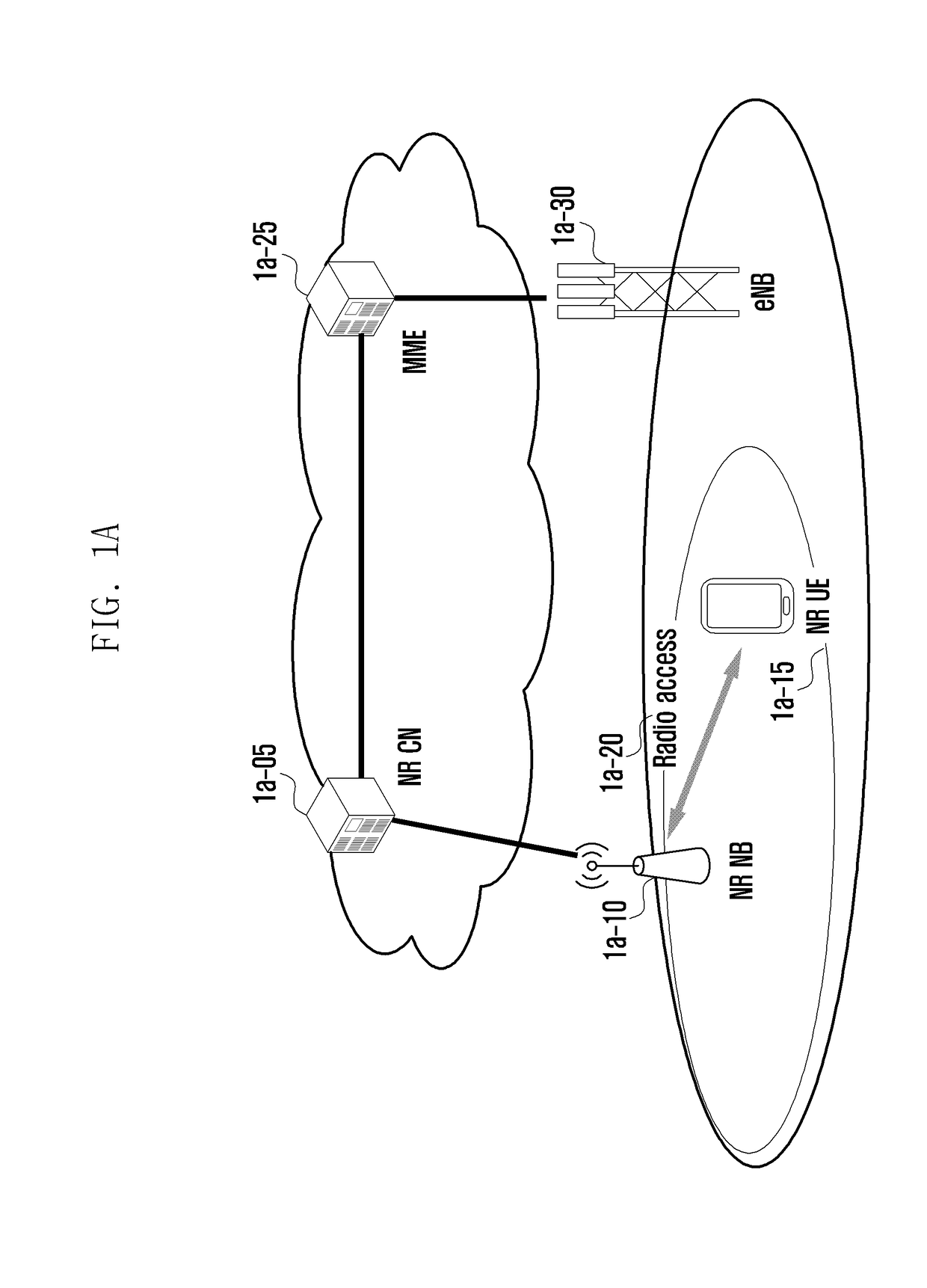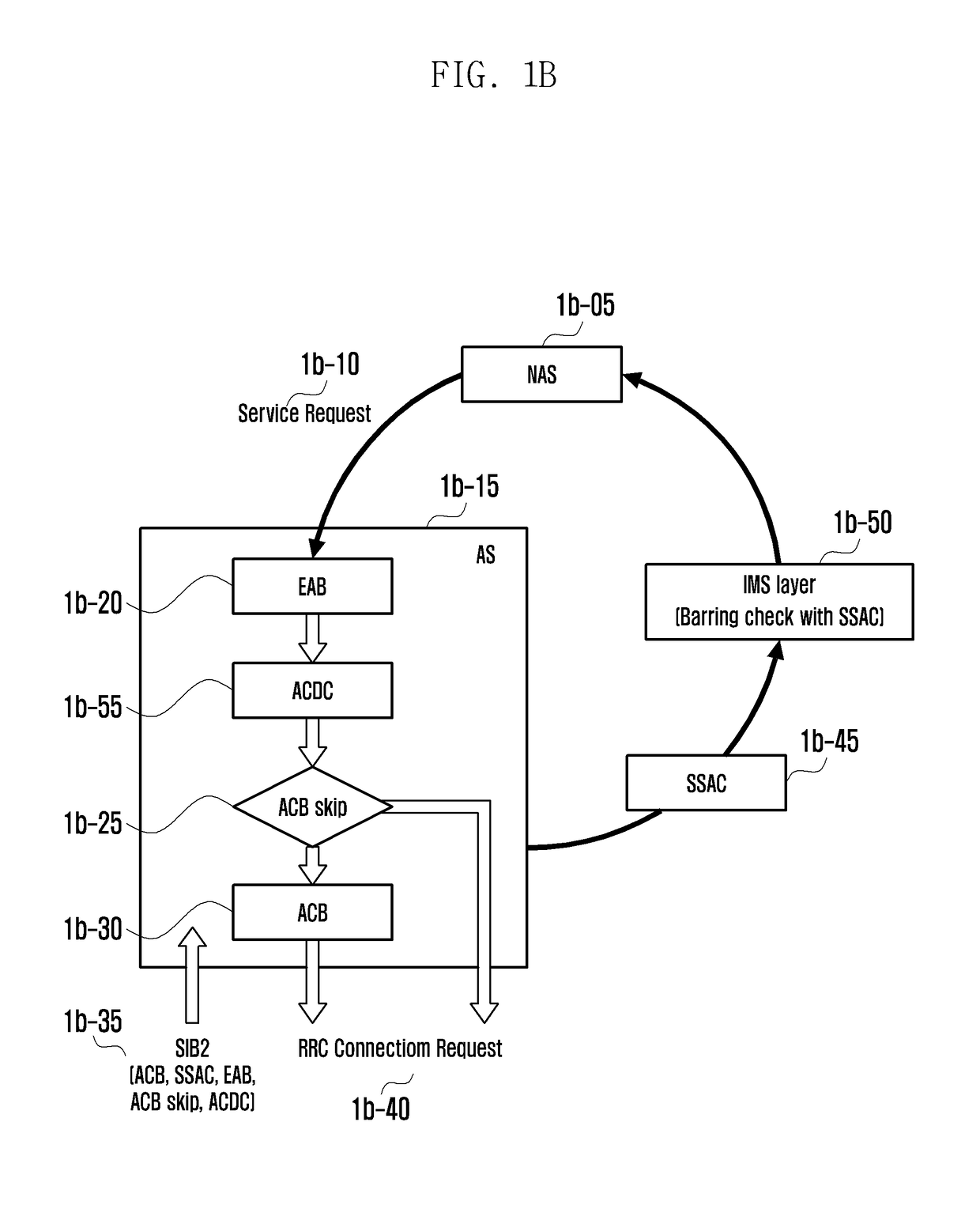Method and apparatus for controlling access in next generation mobile communication system
a mobile communication system and access control technology, applied in electrical devices, connection management, security arrangements, etc., can solve problems such as data loss, transmission delay, data loss, etc., to improve voice over lte (volte) performance, enhance data, and extend coverage
- Summary
- Abstract
- Description
- Claims
- Application Information
AI Technical Summary
Benefits of technology
Problems solved by technology
Method used
Image
Examples
embodiment 1
[0104]FIG. 1A is a diagram illustrating an architecture of a next generation mobile communication system according to an embodiment of disclosure.
[0105]Referring to FIG. 1A, a radio access network 1a-20 of the next generation mobile communication system includes a new radio Node B (NR NB) 1a-10 and a new radio core network (NR CN) 1a-05. A new radio user equipment (hereinafter, referred to as a new radio user equipment (NR UE) or simply UE) 1a-15 connects to an external network via the NR NB 1a-10 and the NR CN 1a-05.
[0106]In FIG. 1A, the NR NB 1a-10 corresponds to the evolved Node B (eNB) in the legacy LTE system. The NR UE 1a-15 connects to the NR NB, which may provide services superior to those of the legacy eNB. In the next generation mobile communication system where all user traffic is served through shared channels, there is a need of an entity for collecting UE-specific status information (such as buffer status, power headroom status, and channel status) and scheduling the U...
embodiment 1-1
[0117]The disclosure proposes a method for mapping an access triggered by a UE NAS to a specific category. In the embodiment 1-1, the UE NAS maps an access to one category.
[0118]In embodiment 1-1, an access is mapped to at least one standardized access category. In addition, an access may not be mapped to any subcategory of the non-standardized access category provided by the network. In the disclosure, the categories provided by the network for use in mapping an access thereto are assigned at least one of predetermined priorities. The triggered access is mapped to a category with the highest priority among the categories to which the access can be mapped. In the disclosure, a category corresponding to “Emergency” belongs to a category set with the highest priority. A category corresponding to a “high priority access” may belong to the category set with the highest priority. The high priority access denotes a mobile communication operator-exclusive or public office-exclusive access,...
embodiment 1-2
[0137]In the embodiment 1-2, the UE NAS maps an access to a standardized access category and, additionally, a non-standardized access category to which the access can be mapped. In the disclosure, the service request that the UE NAS transmits to the UE AS includes the information indicating a standardized access category because the triggered access should be mapped to one standardized access category. At operation 1f-05, no access category list is provided by the UE AS. Accordingly, the operation of determining whether the access can be mapped to one of non-standardized access categories at operation 1f-25 is not performed based on the non-standardized access category included in the list. For example, the UE NAS determines whether there is a non-standardized access category based on only the information on non-standardized access categories supportable by the network that is provided through NAS signaling or application level signaling.
[0138]In embodiment 1-2, the UE NAS may send ...
PUM
 Login to View More
Login to View More Abstract
Description
Claims
Application Information
 Login to View More
Login to View More - R&D
- Intellectual Property
- Life Sciences
- Materials
- Tech Scout
- Unparalleled Data Quality
- Higher Quality Content
- 60% Fewer Hallucinations
Browse by: Latest US Patents, China's latest patents, Technical Efficacy Thesaurus, Application Domain, Technology Topic, Popular Technical Reports.
© 2025 PatSnap. All rights reserved.Legal|Privacy policy|Modern Slavery Act Transparency Statement|Sitemap|About US| Contact US: help@patsnap.com



